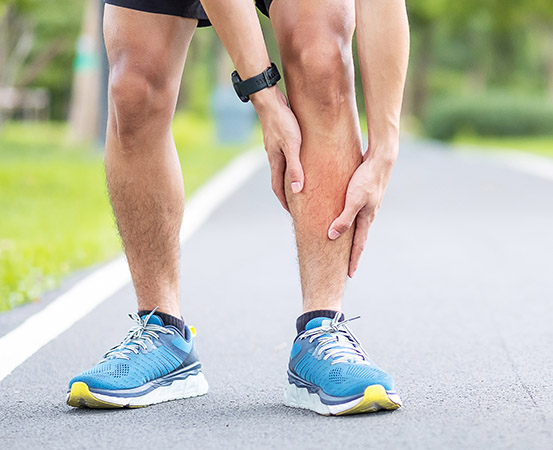The adage that celebrates pain and passion as mutually inclusive (the no pain, no gain cliche), needs to be discarded. At least that’s what sports, musculoskeletal doctors and physios prescribe. However, pain, when it hits, does so uninvited, out of the blue and rings in frustration too.

Mohamad al Bahary’s tryst with pain is a classic and all-so-common case. The 30-year-old electrical engineer from Australia developed a passion for running while in high school.
“I started running during my high school days in Sudan, East Africa,” says Al Bahary. “Running is a popular sport there and that’s when I developed an interest.”
Despite growing up among runners – both who pursue it as a profession or as a hobby – Al Bahary had very little idea about one of the most common injuries runners suffer: shin splints.
“Shin splints happened when I took my running to the next stage,” adds Al Bahary. “I tried to increase my weekly mileage by a huge margin, from 80 km to 120 km.”
READ MORE :
Walking through total knee replacement surgery
Writer’s cramp: causes, symptoms and management
Sprain or strain: how to manage your sports injuries
Al Bahary, after he increased his distance, and thereby intensity, developed pain in his tibia. He consulted a physiotherapist. “After discussing all the pain-related issues with my physiotherapist, I discovered I had shin splints,” he says.
Dr MS Somanna, consultant joint replacement and arthroscopic surgeon, Aster CMI Hospital, Bengaluru (India), says shin splints are seen among athletes, especially runners and gymnasts, dancers and military recruits.
“Shin splints, often referred to as medial tibial stress syndrome, is the pain along the shinbone (tibia), a big bone located at the front of the lower leg,” explains Dr Somanna.
Shin splints causes
It is a by-product of stress on the bone caused by excessive exercise or sudden increase in training intensity. Shinbones bear the brunt when a person indulges in excessive, high-intensity and/or high-impact exercises.
“Repetitive tension on the shinbone and the connective tissues that link the muscles to the bone is what causes shin splints. Most of the time, it involves repetitive, high-impact leg workout,” adds Dr Somanna.
Shin splints may cause mild swelling in the lower leg as well as sensitivity, soreness or pain along the inner side of the shinbone.
“When you stop exercising, the soreness might initially go away. However, the pain may eventually become constant and escalate to a stress reaction or stress fracture,” says Dr Somanna, before listing out the tell-tale symptoms of shin splints:
- Pain in one or both legs.
- The front of your shin may hurt (dull or sharp pain).
- Pressing your shins causes pain.
- Pain that worsens after exercise and improves with rest.
- Even when you are not walking, your legs may hurt if you have severe shin splints.
Treatment and shin splints prevention
Shin splints are identified through a physical examination and a review of the medical history.
“In some instances, imaging tests like X-rays or others can assist in determining whether your discomfort has another probable source, like a stress fracture,” says Dr Somanna.
The condition can be avoided by changing exercise programs gradually, incorporating strength and conditioning workouts and by using appropriate footwear.
“Wearing suitable, well-fitting athletic footwear and replacing running shoes approximately every 350 to 500 miles (560 to 800 kilometres) with insoles that absorb shock helps in preventing shin splints,” says Dr Somanna. “As these might lessen the force exerted on your shins when exercising.
They can be treated with rest, icing, and other self-care techniques.
“If rest, ice and over-the-counter pain medicines don’t help your shin pain, see a doctor,” adds Dr Somanna. “Shin splints may take three to six months to heal, so do not return to your sport or activity too quickly.”
Initially, Al Bahary treated his pain by applying ice, but it didn’t make too much of a difference.
“With the ice, the pain was gone for the moment,” he says. “It was calves’ workout that rescued me from shin splints.”
Strengthening of the muscles is key to preventing the bones from taking the impact while running or exercising. Apart from his strength training and cross-training workouts, massages for recovery and compression socks for additional support helped Al Bahary recover.
“Regular and marathon runners, a person hitting the gym or a person playing or practising for tournaments should have a proper warm-up and cool-down routine. This will help prevent injuries like shin splints,” says Dr Chetan B Shetty, foot and ankle surgeon from KMC Hospital, Mangaluru, India. “Post that, ankle movements and stretches like gastrocnemius, soleus (calf muscles) stretches and tibialis anterior stretches are recommended.”
Al Bahary has kept the shin splints away after sticking to a workout plan that involves running and strengthening exercises (cross-training), with adequate rest. He is a stickler for warmups too and ensures stretching and massaging the muscles down after exercises or a run.
Takeaways
- Shin splints, which cause pain along the shinbone (tibia), are triggered by excessive exercise or a sudden increase in training intensity.
- Athletes, runners, gymnasts, dancers and military recruits are prone to shin splints.
- Wearing corrective footwear, incorporating warm-up and cool-down routines before and after any activity, and strengthening and cross-training help prevent shin splints.
















